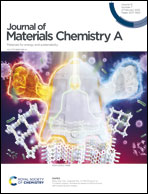Chemically engineered alloy anode enabling fully reversible conversion reaction: design of a C–Sn-bonded aerofilm anode†
Abstract
Using conversion-type materials to design freestanding electrodes is a promising strategy enabling high energy density of batteries, minimal consumption of inactive materials, and a high theoretical capacity. However, their use is not practical due to high irreversibility and excessive volume expansion limit, and also, the complex processes that are required to manufacture binder-free electrodes. Herein, we report a strategy for maximizing the battery reversibility of binderless freestanding electrodes using conversion-type SnO2 quantum particles. The C–Sn bond between the active materials and the graphene conductor immobilizes the redox reaction sites, enabling fast charge transfer and reversible charge/discharge, and the morphological nature of the porous aerofilm satisfies the fast ion access and reversible volume recovery. Unlike typical conversion-type electrodes that undergo huge capacity fading, our freestanding aerofilm SnO2 electrode maintains its capacity within 3% reduction, showing a highly reversible capacity of 1301 mA h g−1. This study provides critical strategies enabling an acceleration of the successful realization of next-generation reversible batteries.



 Please wait while we load your content...
Please wait while we load your content...